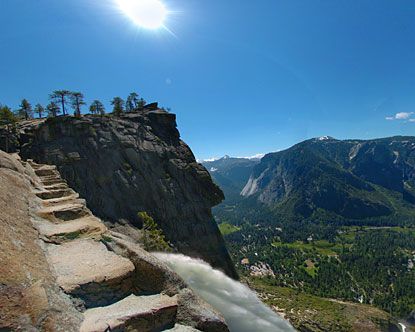Nothing beats taking a beautiful hike to get some relaxation. There’s no denying that a hiking trip is a fantastic opportunity to explore the great outdoors, regardless of whether you’re an experienced adventurer who loves hiking or just someone who appreciates a good view. Hikers all around the world are inspired to take on treks and hiking routes by the fresh, clean air, the seclusion, and the peacefulness of the scenery. It shouldn’t be exclusive to passionate or experienced hikers.
The best hiking routes in the world can be found in the United States. There is no better time to put on your boots and hit the paths if winter weather hills, craggy cliffs, gigantic volcanoes, and ancient forests are calling your name. There are endless fantastic hiking options because it is such a large country with some of the most well-known national parks worldwide. Hiking on some of the top trails in the United States is a great opportunity to explore more of the nation and develop a deeper connection with it.
From coast to coast, I’ve compiled the top trails in the US. for hikers of all experience levels and skill sets. No matter if you’re looking for a day trip, a weekend adventure, or a six-month journey, there is something for everyone here. You might get ideas for your upcoming big trip by reading our list of the best hikes in the U.S.
-
West Maroon Creek Trail
This delightful hike, which links Aspen and Crested Butte, is at its best in July when wildflowers are in bloom. Along the 10-mile path, numerous larkspurs, violets, blue columbines, and white thimbleberries sprinkle beauty. The trail also has some of the most magnificent Rockies views. The Maroon Bells, one of the most famous sights in the state, are reflected in Maroon Lake as you approach the trailhead. The trail ascends 3,000 feet over Maroon Pass before beginning an equally spectacular descent. The trail wanders through a glacier valley and poplar forests in the White River National Forest.
-
Tongass National Forest
In Juneau, the Mendenhall Glacier Visitor Center is the starting point for hikes around the Mendenhall Glacier and the Tongass National Forest. Visitors frequently see bald eagles, sockeye salmon, and black bear cubs in this area, which is a haven for wildlife lovers. Hiking through thick forests and meadows, exploring caverns, or even taking a wooden “boardwalk” trail through muskegs, or swampy bogs, are all available for visitors. The more than 700 miles of trails ensure that hikers never repeatedly see the same views. The 2-mile, quite easy Nugget Falls path offers breathtaking views of the cascade and glacier.
-
Yosemite National Park
Another American treasure with an abundance of great hiking paths is Yosemite National Park. Yosemite National Park is enormous at 1,200 square miles. The Yosemite Valley is home to most of the park’s fantastic hikes. The most popular walk in Yosemite N.P. is the Half Dome Hike. This 14-mile round-trip climb, which rises 5000 feet above the Yosemite Valley level, may be completed in 10 to 12 hours. Prepare yourself for the final 400 feet of cable use, which enables hikers to reach the peak without requiring climbing gear.
-
Penobscot & Sargent Mountains
This hike is the most rewarding in Acadia National Park because of its two summits, rugged scrambles, and crystal-clear ponds. The 5.4-mile round starts and ends at Jordan Pond House, a sophisticated cafe that appeals with post-hike popovers but is otherwise tough. To ascend Sargent Mountain’s 1,373-foot summit, you must squeeze between stones as you scale Penobscot Mountain, descend to Sargent Pond, and then climb past the tree line. The expansive view spans nearly the entire Down East Coast and has water on three sides.
-
Shenandoah National Park Hikes
Only 75 miles separate Virginia’s Shenandoah National Park from the bustle of Washington, D.C. There are deer, birdsong, and a bright, starry night sky on the park’s 200,000 acres of protected territory. In addition, the park offers more than 500 miles of hiking routes, including 101 miles of the Appalachian Trail, a portion of which may be hiked in a single day. Each trail features unique features like waterfalls, vistas, and dense forests.
-
Mount Whitney
Every hiker wants to climb Mount Whitney, which is in California. This 22.5-mile out-and-back track, which climbs 6,656 feet in height to reach 14,494 feet, can, believe it or not, be mounted in a single day, but we advise a multi-day backpacking excursion. This strenuous climb leads you past stunning mountain peaks, lakes, and valleys with breathtaking vistas. It takes true courage to climb to the top.
-
Smith Rock
Many hiking paths in Oregon lead through rocky beaches, deep forests, and alpine terrain. Oregon is one of America’s top hiking destinations, boasting 361 state parks and 11 national forests. You can hike a portion of the massive Pacific Crest Trail, which connects Mexico and Canada, through Oregon, but many other options are available in the state. We’ve decided to hike Smith Rock Misery Ridge trail because it’s one of the more well-known hiking routes in the country. Although it is only 3.5 miles long, it is steep and beautiful. From a high point on Misery Ridge, you may observe serene mirror lakes, vertical granite rock walls, and rock formations like The Monkey Face Rock.
-
Great Smoky Mountains National Park
The “Great Smoky Mountains National Park” in Tennessee and North Carolina is well-known throughout the world for its wide variety of plants and animals, as well as its expansive mountains for hiking and exploring. The park also offers the “Hike the Smokies” challenge, which offers exclusive distance pins to hikers who have covered more than 100 miles of the park. Miles of paved and unpaved pathways offer vistas of waterfalls and old-growth trees throughout the park. The Appalachian Trail climb to Charlies Bunion provides stunning views of the mountains and woodlands.
-
Nankoweap Trail
This trail is one of the Grand Canyon’s toughest excursions, but the rewards are incredible. It was first constructed by geologist J.W. Powell in the 1880s and descends 6,000 feet in 14 miles from the north rim towards the Colorado River, using an old Native American track as a guide. It’s hard for the faint of heart; you’ll switch back your way down to Nankoweap Creek and the river over sandstone cliffs, steep Redwall limestone, and a slope of yellow shale. The canyon that unfolds before you and echoes with the scream of rapids is a spectacular setting for this solo camping. Unfortunately, you then have to go back and climb those 14 miles.
-
John Muir Trail
This 211-mile route from Yosemite Valley to Mount Whitney crosses the Sierra Nevada Mountains and is legendary for a cause. Every step brings one closer to mesmerizing views of high passes, alpine meadows, lakes, and sequoias. The route begins with well-known sights like Half Dome and Vernal Falls, then climbs through the Ansel Adams Wilderness to the highest point in the contiguous United States. The Pacific Crest Trail most picturesque portion is blessed with a mild temperature and plenty of sunshine. Most hikers travel from north to south between July and October to avoid the snow, acclimate to higher altitudes, and get in shape before ascending 14,495-foot Mount Whitney.








